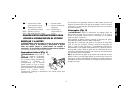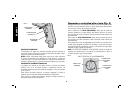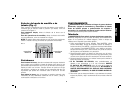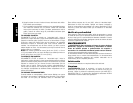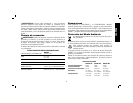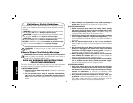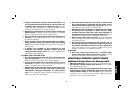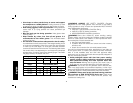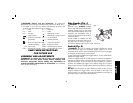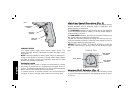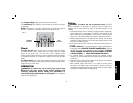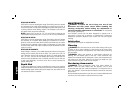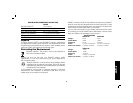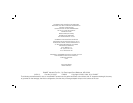
17
English
For straight drilling, align selector with drill bit symbol.
For hammering, align selector with the hammer symbol, as shown
in the figure.
NOTE: The selector must be in either drill or hammer/drill mode at
all times. There are no operable positions between the two.
FIG. 4
DRILL
SETTING
HAMMER
SETTING
Chuck
To insert the bit, open chuck jaws by turning collar with fingers
counterclockwise (when viewed from the chuck end) and insert
shank of bit about 3/4" (19 mm) into chuck. Tighten chuck
collar by hand. Place chuck key in each of the three holes and tighten
in clockwise direction. It’s important to tighten chuck with all three
holes.
To release the bit, turn collar key counterclockwise in just one hole,
then loosen the chuck by hand turning collar counterclockwise (when
viewed from the chuck end).
OPERATION
WARNING: To reduce the risk of injury, turn unit off and
disconnect tool from power source before installing and
removing accessories, before making any adjustments or
removing/installing attachments or accessories. An accidental
start-up can cause injury.
Drilling
WARNING: To reduce the risk of personal injury, ALWAYS
ensure workpiece is anchored or clamped firmly. If drilling thin
material, use a wood “back-up” block to prevent damage to the
material.
1. Use sharp drill bits only. For WOOD, use twist drill bits, spade bits,
power auger bits, or hole saws. For METAL, use steel twist drill
bits or hole saws. For MASONRY, such as brick, cement, cinder
block, etc., use carbide-tipped bits rated for percussion drilling.
2. Always apply pressure in a straight line with the bit. Use enough
pressure to keep drill biting, but do not push hard enough to stall
the motor or deflect the bit.
3. Hold tool firmly with both hands to control the twisting action of
the drill.
4. IF DRILL STALLS, it is usually because it is being overloaded or
improperly used. RELEASE TRIGGER IMMEDIATELY, remove
drill bit from work, and determine cause of stalling. DO NOT
CLICK TRIGGER ON AND OFF IN AN ATTEMPT TO START
A STALLED DRILL — THIS CAN DAMAGE THE DRILL.
5. To minimize stalling or breaking through the material, reduce
pressure on drill and ease the bit through the last fractional part
of the hole.
6. Keep the motor running when pulling the bit back out of a drilled
hole. This will help prevent jamming.
7. With variable speed drills there is no need to center punch
the point to be drilled. Use a slow speed to start the hole and
accelerate by squeezing the trigger harder when the hole is deep
enough to drill without the bit skipping out.



